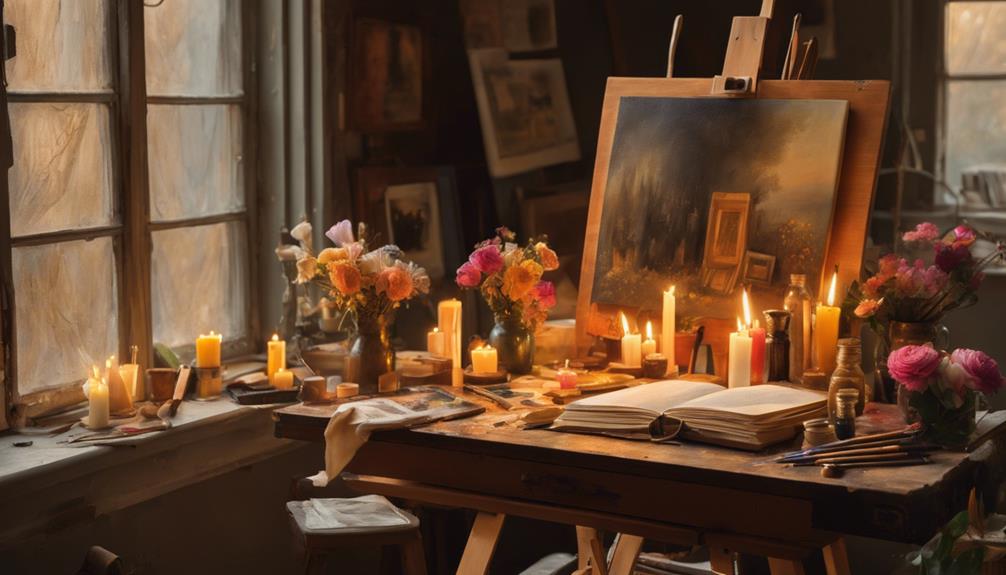You hold the brush that paints vivid worlds with words, and with every carefully crafted sentence, you can evoke emotions, awaken sensations, and transport your readers to uncharted territories. As you weave sensory details into your poetry, you'll craft an immersive experience that whispers secrets to your readers' senses. Figurative language will be your magic wand, conjuring metaphors, similes, and personification to bring your words to life. With each stroke of your pen, you'll transport your readers to a world that's both familiar and unknown, where the boundaries of reality blur and the imagination knows no bounds. And as you continue, the canvas of your creativity will unfold, waiting to be filled with the vibrant colors of your imagination.
Building Blocks of Imagery

As you craft your poem, you'll find that sensory details are the bricks with which you'll build your imaginative edifice, transporting your readers to a world of wonder. These details will weave together to form image patterns, creating a rich tapestry that immerses your audience in the world you've created. To craft effective image patterns, you'll need to tap into your figurative roots, drawing upon metaphors, similes, and personification to evoke emotions and sensations in your readers. By doing so, you'll create a multisensory experience that resonates long after the final line has been read. As you explore the domain of image patterns, you'll discover that the most evocative poetry often emerges from the subtle interplay between the concrete and the abstract. By balancing the tangible with the intangible, you'll create a world that's both familiar and unknown, inviting your readers to step into the vibrant, pulsing landscape of your imagination.
Crafting Vivid Descriptions

When you craft vivid descriptions, you're not just painting pictures with words – you're conjuring sensory experiences that envelop your readers, making them feel the warmth of a summer breeze, smell the sweet scent of blooming flowers, or taste the tang of saltwater on their lips.
To master this craft, you'll need to employ syntax strategies that weave together sensory details, creating a rich tapestry of descriptive density. This means balancing short, snappy sentences with longer, more languid ones, allowing your readers to breathe in the atmosphere you're creating. Play with sentence structure, using enjambment to sweep your readers up in a wave of sensory input or caesura to create a moment of stillness. By varying your sentence length and structure, you can control the pace at which your readers absorb your descriptions, drawing them deeper into the world you're creating. Remember, the goal is to craft descriptions that are both vivid and immersive, transporting your readers to a world that's both familiar and unknown.
Using Sensory Language Effectively

Immerse yourself in the domain of sensory language, where verbs like 'sizzle,' 'whisper,' and 'unfolding' can evoke the tactile sensation of rough tree bark, the soft murmur of a lover's voice, or the slow revelation of a sunrise. This is where the magic of poetry unfolds, where you can weave a tapestry of sensory experiences that transport your readers to new dimensions. By incorporating sensory triggers, you can awaken your readers' senses, making them feel the warmth of a crackling fire or the sting of a bitter winter wind. Figurative language, such as metaphors and similes, can further enhance the sensory experience, allowing your readers to taste the sweetness of ripened fruit or smell the salty ocean air. As you craft your poem, remember that effective sensory language is not just about describing what's seen, but about evoking the full range of human experience. By doing so, you'll create a rich, immersive world that invites your readers to linger and explore.
Creating Atmosphere With Imagery

With every brushstroke of language, you're not only painting a picture, but crafting an atmosphere that envelops your reader, drawing them into the very fabric of your poem. As you weave words together, you're creating a mood landscape that transports your reader to a specific time and place. The key is to evoke a sense of being, rather than simply telling. By doing so, you'll craft an atmosphere that's essential, allowing your reader to step into the world you've created.
Atmospheric tension is vital in creating a mood that resonates with your reader. By using sensory language, you can build tension or release it, manipulating the mood of your poem to evoke a specific response. Think of your words as brushstrokes on a canvas, each one building upon the last to create a rich tapestry of atmosphere. As you craft your poem, remember that every word, every phrase, and every sentence is an opportunity to shape the mood landscape, drawing your reader deeper into the world you've created.
Show, Don't Tell: The Power

As you step into the world of poetry, you're not just conveying a message, you're crafting an experience that unfolds before your reader's eyes, and the art of 'show, don't tell' becomes the master key that opens the doors to a truly immersive encounter. This subtle yet powerful technique allows you to weave a tapestry of sensory details that envelop your reader, drawing them into the heart of your poem. By showing, rather than telling, you create a sense of intimacy, inviting your reader to become an active participant in the narrative. This, in turn, fosters poetic nuance, as the reader is free to interpret and fill in the gaps, adding depth and complexity to the poem. The 'show, don't tell' approach also masterfully builds narrative tension, as the reader is left to piece together the puzzle, their imagination ignited by the carefully crafted hints and suggestions. By embracing this technique, you'll find your poetry takes on a life of its own, pulsing with a vibrant, living energy that resonates deeply with your audience.
Evoking Emotions Through Imagery

Your words can be the brushstrokes that paint vivid emotional landscapes, inviting your reader to step into the intimate, sensory world you've created. As you craft your poem, you're not just describing a scene – you're evoking emotions that resonate deep within your reader's psyche. The key to emotional resonance lies in the authenticity of your imagery. When you tap into your own emotional experiences, your words become infused with a sincerity that transcends the page.
You're not just describing a sunset, you're conveying the warmth on your skin, the smell of saltwater, and the sense of peace that washes over you as the sky turns pink. Your reader should feel the sting of tears, the ache of longing, or the thrill of joy as they immerse themselves in your words. Emotional authenticity is what separates a good poem from a great one. By tapping into your own emotional depths, you'll create a world that's not just visually stunning but emotionally resonant, leaving your reader breathless and yearning for more.
Balancing Description With Restraint

In the delicate dance of descriptive poetry, you must carefully calibrate the ratio of vivid details to restrained subtlety, lest your words overwhelm the senses and suffocate the imagination. Too much description can be suffocating, a heavy fog that obscures the reader's vision. You must learn to wield restraint, to know when to hold back and let the reader's imagination fill in the gaps.
Think of it as a gentle whisper, a subtle suggestion rather than a loud declaration. Limited embellishments can be incredibly powerful, allowing the reader's mind to fill in the blanks and become an active participant in the creative process. Deliberate omission, too, can be a potent tool, leaving room for interpretation and fostering a deeper connection with the reader.
Editing for Maximum Impact

With every stroke of your editing pen, you're sculpting the contours of your poem, refining the language to evoke a visceral response that resonates deep within the reader. As you revise, you're not merely tweaking words – you're orchestrating a symphony of emotions, carefully calibrating the rhythm and cadence of your language to conjure a world that's at once intimate and expansive.
To achieve this, employ revision techniques that hone in on the essence of your message. Identify phrases that feel cumbersome or vague, and replace them with language that's visceral, tactile, and evocative. Make syntax adjustments to create a sense of flow, guiding the reader's eye through the poem with deliberate line breaks and enjambments. Cut any words that don't contribute to the overall impact, allowing the remaining language to shine with crystalline clarity. By doing so, you'll distill your poem to its most potent form, crafting an experience that will leave readers breathless and yearning for more.
Frequently Asked Questions
Can I Use Too Much Imagery in a Poem?
As you weave a tapestry of words, be cautious not to suffocate your reader with an avalanche of imagery. Too much of a good thing can be overwhelming, like a heavy perfume that chokes the senses. Don't let your poem become a sensory overload, where the reader drowns in a sea of descriptions. Strike a balance, lest your words become a cacophony that numbs the mind.
How Do I Avoid Clichés in My Descriptive Language?
As you craft your poem, you'll want to sidestep clichés that can make your language feel stale. To avoid them, aim for fresh perspectives that bring new eyes to familiar scenes. Seek linguistic nuance by exploring the senses, letting the scent of rain or the warmth of sunlight seep into your words. By doing so, you'll create vibrant descriptions that transport your readers to uncharted territories, making your poetry a truly immersive experience.
What's the Difference Between a Simile and a Metaphor?
You're wondering about the difference between similes and metaphors. A simile is a literal comparison, saying something is "like" or "as" something else. It's a gentle nudge, a whispered suggestion. A metaphor, on the other hand, takes poetic license, declaring one thing is another. It's a bold declaration, a vibrant splash of color on the canvas of your imagination. With metaphors, you're free to create new worlds, where the ordinary becomes extraordinary.
Can I Use Imagery to Convey Abstract Ideas or Emotions?
You can conjure emotional resonance by using imagery to convey abstract ideas or emotions. It's like weaving a tapestry of sensations, transporting readers to a domain where concepts unfold like petals of a flower. By crafting vivid descriptions, you can breathe life into conceptual frameworks, making them tangible and relatable. Your words become the brushstrokes that paint the canvas of the reader's mind, evoking feelings and connections that linger long after the poem is read.
Do I Need to Be a "Visual" Person to Write Vivid Imagery?
You're a master chef, whisking together ingredients to create a culinary symphony, but instead of flavors, you're blending sensory details to craft vivid imagery. You don't need to be a 'visual' person to write evocative descriptions; your literary inclinations and creative persona can flourish regardless. Your imagination is the canvas, and your words are the brushstrokes. Tap into your senses, and your writing will sizzle with sensory depth, transporting readers to new domains.


